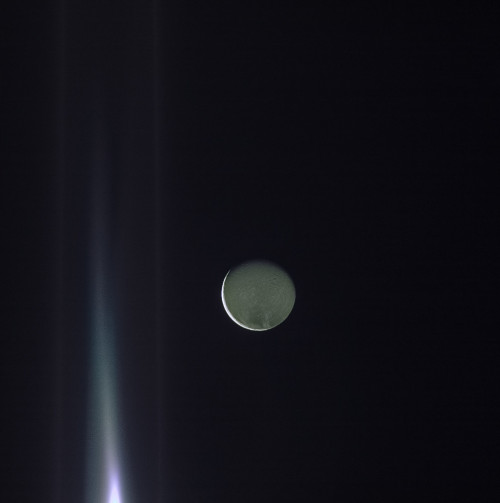🐈⬛🐈🌌🌆🌕
🐈⬛🐈🌌🌆🌕

Pixabay
More Posts from Monstrous-mind and Others
🍁🍂🎃🍂🍁🍃🐈📚📖☕



Der Baum im Herbstlicht & Das Leuchten des Waldes by Oliver Henze
🔭🌃🌌


Galaxy UGC 2885 may be the largest one in the local universe. It is 2.5 times wider than our Milky Way and contains 10 times as many stars. This galaxy is 232 million light-years away, located in the northern constellation of Perseus.
Credit: NASA, ESA, and B. Holwerda (University of Louisville)
🔭🌃🌌

Ocean on the moon Europa
Scientists' consensus is that a layer of liquid water exists beneath Europa's surface, and that heat from tidal flexing allows the subsurface ocean to remain liquid.

Europa's surface temperature averages about 110 K (−160 °C; −260 °F) at the equator and only 50 K (−220 °C; −370 °F) at the poles, keeping Europa's icy crust as hard as granite. The first hints of a subsurface ocean came from theoretical considerations of tidal heating (a consequence of Europa's slightly eccentric orbit and orbital resonance with the other Galilean moons). Galileo imaging team members argue for the existence of a subsurface ocean from analysis of Voyager and Galileo images.

The most dramatic example is "chaos terrain", a common feature on Europa's surface that some interpret as a region where the subsurface ocean has melted through the icy crust.
The thin-ice model suggests that Europa's ice shell may be only a few kilometers thick. However, most planetary scientists conclude that this model considers only those topmost layers of Europa's crust that behave elastically when affected by Jupiter's tides.

The Hubble Space Telescope acquired an image of Europa in 2012 that was interpreted to be a plume of water vapour erupting from near its south pole The image suggests the plume may be 200 km (120 mi) high, or more than 20 times the height of Mt. Everest.
Life?
So far, there is no evidence that life exists on Europa, but Europa has emerged as one of the most likely locations in the Solar System for potential habitability. Life could exist in its under-ice ocean, perhaps in an environment similar to Earth's deep-ocean hydrothermal vents. Even if Europa lacks volcanic hydrothermal activity, a 2016 NASA study found that Earth-like levels of hydrogen and oxygen could be produced through processes related to serpentinization and ice-derived oxidants, which do not directly involve volcanism.

In 2015, scientists announced that salt from a subsurface ocean may likely be coating some geological features on Europa, suggesting that the ocean is interacting with the seafloor. This may be important in determining if Europa could be habitable. The likely presence of liquid water in contact with Europa's rocky mantle has spurred calls to send a probe there.
Missions

Europa Clipper is an interplanetary mission in development by NASA comprising an orbiter. Set for a launch in October 2024, the spacecraft is being developed to study the Galilean moon Europa through a series of flybys while in orbit around Jupiter.

The Europa Lander is a proposed astrobiology mission concept by NASA to Europa, an icy moon of Jupiter. If funded and developed as a large strategic science mission, it would be launched in 2027 to complement the studies by the Europa Clipper orbiter mission and perform analyses on site. NASA's budget for fiscal year 2021 neither mandates nor allocates any funds to the mission leaving its future uncertain.
The objectives of the mission are to search for biosignatures at the subsurface ≈10 cm, to characterize the composition of non-ice near-subsurface material, and determine the proximity of liquid water and recently erupted material near the lander's location.
source
🔭🪐🌌🌘☄️

2024 June 23
The Colors of Saturn from Cassini Image Credit: NASA, ESA, JPL, ISS, Cassini Imaging Team; Processing & License: Judy Schmidt
Explanation: What creates Saturn’s colors? The featured picture of Saturn only slightly exaggerates what a human would see if hovering close to the giant ringed world. The image was taken in 2005 by the robot Cassini spacecraft that orbited Saturn from 2004 to 2017. Here Saturn’s majestic rings appear directly only as a curved line, appearing brown, in part from its infrared glow. The rings best show their complex structure in the dark shadows they create across the upper part of the planet. The northern hemisphere of Saturn can appear partly blue for the same reason that Earth’s skies can appear blue – molecules in the cloudless portions of both planet’s atmospheres are better at scattering blue light than red. When looking deep into Saturn’s clouds, however, the natural gold hue of Saturn’s clouds becomes dominant. It is not known why southern Saturn does not show the same blue hue – one hypothesis holds that clouds are higher there. It is also not known why some of Saturn’s clouds are colored gold.
∞ Source: apod.nasa.gov/apod/ap240623.html
🔭🌃🌌🐈🍂🍁

First Ever Image of a Multi-Planet System around a Sun-like Star Captured by ESO Telescope
The European Southern Observatory’s Very Large Telescope (ESO’s VLT) has taken the first ever image of a young, Sun-like star accompanied by two giant exoplanets. Images of systems with multiple exoplanets are extremely rare, and — until now — astronomers had never directly observed more than one planet orbiting a star similar to the Sun. The observations can help astronomers understand how planets formed and evolved around our own Sun.
The two gas giants orbit their host star at distances of 160 and about 320 times the Earth-Sun distance. This places these planets much further away from their star than Jupiter or Saturn, also two gas giants, are from the Sun; they lie at only 5 and 10 times the Earth-Sun distance, respectively. The team also found the two exoplanets are much heavier than the ones in our Solar System, the inner planet having 14 times Jupiter’s mass and the outer one six times.
Source
🍂🍁🍂🍁

~ Orange and Brown ~
🔭🌌


Dione (moon of Saturn) 2005 and 2015
Credit: NASA/JPL-Caltech/SSI/Kevin M. Gill
-
 foreverfitnesspositivity liked this · 6 months ago
foreverfitnesspositivity liked this · 6 months ago -
 basicleeme liked this · 6 months ago
basicleeme liked this · 6 months ago -
 italsir liked this · 6 months ago
italsir liked this · 6 months ago -
 mistymountainway reblogged this · 6 months ago
mistymountainway reblogged this · 6 months ago -
 mistymountainway liked this · 6 months ago
mistymountainway liked this · 6 months ago -
 iamgroot65 liked this · 6 months ago
iamgroot65 liked this · 6 months ago -
 yourwizard1969 liked this · 6 months ago
yourwizard1969 liked this · 6 months ago -
 mohawke035 liked this · 6 months ago
mohawke035 liked this · 6 months ago -
 magic-secrets-inher-eyes liked this · 6 months ago
magic-secrets-inher-eyes liked this · 6 months ago -
 magic-secrets-inher-eyes reblogged this · 6 months ago
magic-secrets-inher-eyes reblogged this · 6 months ago -
 hazeleyesnstarryskies reblogged this · 6 months ago
hazeleyesnstarryskies reblogged this · 6 months ago -
 coyote-mint reblogged this · 6 months ago
coyote-mint reblogged this · 6 months ago -
 taoduck reblogged this · 7 months ago
taoduck reblogged this · 7 months ago -
 ciruellas reblogged this · 7 months ago
ciruellas reblogged this · 7 months ago -
 happydistraction reblogged this · 7 months ago
happydistraction reblogged this · 7 months ago -
 jasmiine-ann reblogged this · 7 months ago
jasmiine-ann reblogged this · 7 months ago -
 diarythebookwyrm reblogged this · 9 months ago
diarythebookwyrm reblogged this · 9 months ago -
 geokapsposts liked this · 9 months ago
geokapsposts liked this · 9 months ago -
 kat68 liked this · 11 months ago
kat68 liked this · 11 months ago -
 covenawhite66 liked this · 11 months ago
covenawhite66 liked this · 11 months ago -
 futuristicmakerbattoad reblogged this · 1 year ago
futuristicmakerbattoad reblogged this · 1 year ago -
 futuristicmakerbattoad liked this · 1 year ago
futuristicmakerbattoad liked this · 1 year ago -
 thatonebookworm31 liked this · 1 year ago
thatonebookworm31 liked this · 1 year ago -
 noblegasxenon liked this · 1 year ago
noblegasxenon liked this · 1 year ago -
 that-ghost-pal reblogged this · 1 year ago
that-ghost-pal reblogged this · 1 year ago -
 that-ghost-pal liked this · 1 year ago
that-ghost-pal liked this · 1 year ago -
 azapofinspiration reblogged this · 1 year ago
azapofinspiration reblogged this · 1 year ago -
 azapofinspiration liked this · 1 year ago
azapofinspiration liked this · 1 year ago -
 trickbop liked this · 1 year ago
trickbop liked this · 1 year ago -
 marypsue reblogged this · 1 year ago
marypsue reblogged this · 1 year ago -
 victor-ribeiro-stuff reblogged this · 1 year ago
victor-ribeiro-stuff reblogged this · 1 year ago -
 victor-ribeiro-stuff liked this · 1 year ago
victor-ribeiro-stuff liked this · 1 year ago -
 protagx reblogged this · 1 year ago
protagx reblogged this · 1 year ago -
 heathen-beast reblogged this · 1 year ago
heathen-beast reblogged this · 1 year ago -
 orig-suckamunch reblogged this · 1 year ago
orig-suckamunch reblogged this · 1 year ago -
 orig-suckamunch liked this · 1 year ago
orig-suckamunch liked this · 1 year ago -
 jedi-skyforce liked this · 1 year ago
jedi-skyforce liked this · 1 year ago -
 ghostie-jakxy-gray liked this · 1 year ago
ghostie-jakxy-gray liked this · 1 year ago -
 pomrania liked this · 1 year ago
pomrania liked this · 1 year ago -
 eregyrn-falls reblogged this · 1 year ago
eregyrn-falls reblogged this · 1 year ago -
 eregyrn-falls liked this · 1 year ago
eregyrn-falls liked this · 1 year ago -
 ofwhimsicaldreams reblogged this · 1 year ago
ofwhimsicaldreams reblogged this · 1 year ago -
 justforfollowingpeople liked this · 1 year ago
justforfollowingpeople liked this · 1 year ago -
 actiaslunaris reblogged this · 1 year ago
actiaslunaris reblogged this · 1 year ago -
 imthelostwanderer liked this · 1 year ago
imthelostwanderer liked this · 1 year ago -
 secretumpoeta liked this · 1 year ago
secretumpoeta liked this · 1 year ago -
 pascalskittycat reblogged this · 1 year ago
pascalskittycat reblogged this · 1 year ago -
 pascalskittycat liked this · 1 year ago
pascalskittycat liked this · 1 year ago -
 blackpointgame liked this · 1 year ago
blackpointgame liked this · 1 year ago
My ambition is handicapped by laziness. -C. Bukowski Me gustan las personas desesperadas con mentes rotas y destinos rotos. Están llenos de sorpresas y explosiones. -C. Bukowski. I love cats. Born in the early 80's, raised in the 90's. I like Nature, Autumn, books, landscapes, cold days, cloudy Windy days, space, Science, Paleontology, Biology, Astronomy, History, Social Sciences, Drawing, spending the night watching at the stars, Rick & Morty. I'm a lazy ass.
222 posts
